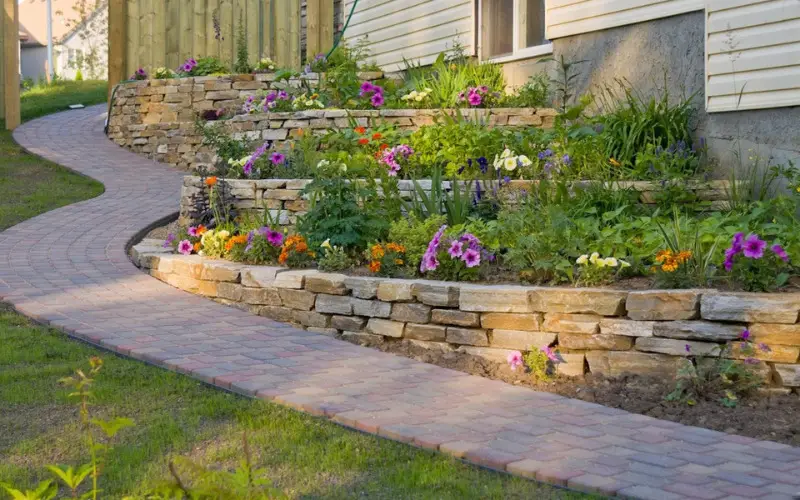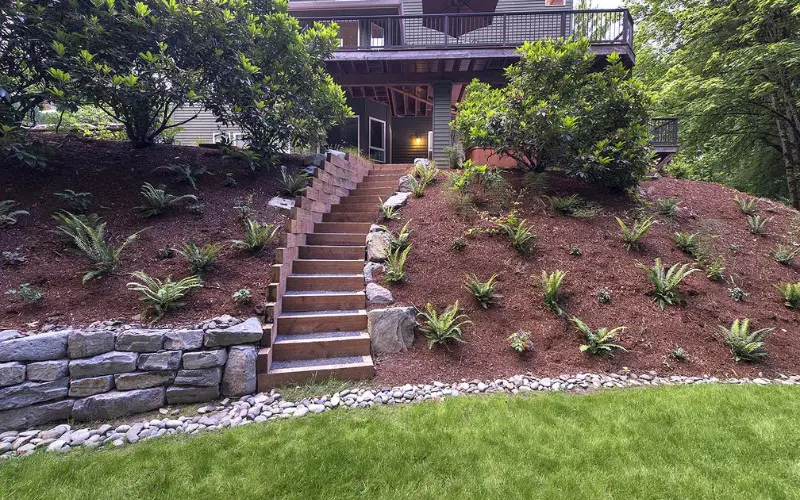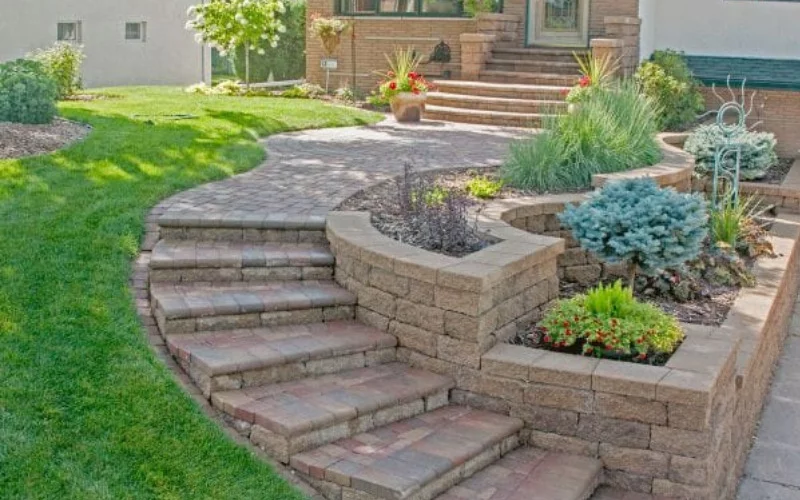A steep hill in your backyard can pose a big landscaping challenge, especially as slopes present drainage challenges and are prone to soil erosion. You can, however, turn your steeply slope into a scenic vista that will accentuate the beauty of your home.
From planting flowers and trees and building stairways and pathways to terracing and constructing a retaining wall, you can transform your steep backyard and give it more value.
To do this effectively, you must understand the slope, analyze the slope and be sure you know to deal with the drainage of the area. Read along and discover how to make the most of your steep backyard.
Factors To Consider Before Landscaping Your Steep Hill Backyard
You must keep a few preliminary considerations in mind as you try to transform the steep hill in your backyard. They include:
1. Understand the slope:
The first thing to do in fixing your hilly backyard is to determine how steep the hill is; this is the best approach to employ.
If the hill is not so steep, you can adopt rocks, plants and mulch on the ground, but for much steeper hills, terracing or retaining walls will come in handy and serve as a means of controlling erosion.
2. Understand The Soil:
The soil type in your backyard will determine how much erosion can happen, how much water can drain out of the soil, and the amount retained. It will also inform the best plant that can be grown there too.
If you have sand or silt soil, you must understand that your backyard will be prone to erosion, unlike you have with clay, and hence you will need something like a retaining wall or terracing to tackle such a steep hill.
3. Understand The Drainage
This is closely related to the soil type in your backyard. You must determine where the water drains from the slope and if it is moving down or across your backyard.
It is also key to look for the water channels and determine whether they are wide or narrow; these factors will affect erosion in your backyard.
All these will help you determine the best way of dealing with the drainage of your soil, especially in terms of the drainage system that will work.
For instance, you can install a French drain to divert water runoff that collects at the bottom of the slope. Adequate drainage prevents or reduces erosion and ensures that your walls don’t shift, crack or collapse.
4. Understand How To Go Around The Hill
This might not sound like a serious issue, but you must determine how best to get around your steep backyard in the safest way possible.
You must know if you can walk up and down the hill without holding on to anything for stability or if you must always hold on to something.
You don’t want your kids and visitors to find navigating your backyard difficult or be subjected to any safety hazard like tipping, falling off a hill, etc.
5. Understand You Might Need A Professional
While it is great to be a DIYer, you must know that some landscaping exploits can only be accomplished by a professional.
For instance, for complex renovation, you will need to enlist the need of building experts like architects and landscape designers. They will better understand your landscape and offer professional advice on what will suit your space.
Another advantage of using professionals in giving the steep hill in your backyard is that they provide all the necessary designs and tools for making complex designs like retaining walls, rock walls, waterfalls and the like.
What To Do With Steep Hill In Backyard

Whatever you decide to change the feel of your steep backyard, some things must be done sequentially if success is recorded. The first stage is the planning phase, where you articulate what exactly you want to be done on paper.
a. Drawing Up A Design
Whatever you plan to do with the steep hill of your backyard, you have to capture it as a design. Except you are an expert, you should get a professional to carefully design what your backyard will look like, as this will form the template for the work.
You could look for inspiration for the design from around you or on the Internet. You will be amazed at the beautiful designs you find that will suit your home.
Safety in terms of the ease of getting around your steep backyard is one of the key components that make for a safe backyard; hence you need to make accessibility a top consideration in the design.
Remember that kids and visitors who might not know the layout of your backyard will come around. Hence you must ensure that your design captures how easy it is to access your backyard.
To make your design cohesive, you should pick a theme that suits your style a d personality and ensure that the materials, home exterior decorations, plants and all other aspects of the design are available and in harmony.
For instance, if you are going for a rustic or cottagecore feel, then you will want to incorporate rough boulders, railroad ties, and native plants, but if you are coming for a more modern or futuristic design, then you will need a cleaner, perhaps inorganic materials to complement.
While you are mainly concerned about the steep hill in your backyard, you must create a destination around the backyard where everyone can sit and enjoy the scenic beauty of your space.
Hence in this planning phase, constructing a patio, seating area or even installing a fire pit will create a spot where you and your loved ones and guest can sit and drink in all the beauty of your backyard.
You should also make up your mind on the planting bed you will use, be it a water-wise strip, rock gardens, shade borders, vegetable plot, planters or mixed border.
b. Plan On How To Stabilize The Slope
There are different ways you can stabilize the slope of your backyard, including:
1. Use Mulch
If the slope of your backyard is gentle, then you can choose the right tho and color of mulch that will be laid on it to protect the topsoil from being washed away by the elements, prevent the proliferation of weeds and also help the soil to retain moisture.
2. Use Landscape fabric
Landscape fabric is best used on a gentle or moderate slope because it effectively reduces, if not prevents, erosion. With this material, you will have to deal with soil compaction when the material wears out.
3. Boulders Or Rocks Works Too
You can use boulders or individual rocks arranged along the hill to keep topsoil runoff at a minimum. If the hill of your backyard is very steep, they go for angular boulders, which can dig into the soil and hence cannot easily roll or be washed away like smooth rocks.
4. Retaining wall
You can decide to cut away a part of the hillside of your backyard and then construct a vertical wall that will hold the soil and keep it from eroding.
Retaining walls are made from cinder blocks, railroad tiles, lumber, bricks and rocks, which are a great way of stabilizing steep backyards.
5. Make a Rock wall
You can stack rocks that are adhered together or loose into a wall. These rocks should be stacked adjacent to a sidewalk and at the back of the property. You can also use this rock wall to define the different ground levels of the backyard.
6. Terrace The Backyard.
If you are dealing with a steep hill, you can divide the backyard based on its different levels with a series of retaining walls and flat surfaces. This leaves a terraced backyard, and you can plant flowers in the flat areas.
Alternatively, you can convert the flat land into a seating area, fix a fire pit, or generally fix any recreational facility like a gazebo.
7. Stairways and pathways Are Classic
As basic as they sound, stairways and pathways allow you to easily access your backyard and connect l the other parts of the backyard, but it also helps keep the soil stable.
You can make these steps with slabs, would or stone blocks. If the slope of your space is gentle, then pavers or gravels will do the trick. You can make the pathway of steeper hills safer to navigate by simply creating switchbacks.
8. Waterfall Is Whimsical
You can add a touch of class and take your landscaping up a notch by taking advantage of the elevation of your steep hill backyard and installing a tumbling waterfall. You, however, must seek ways of stabilizing the waterfall to remain secure.
9. Tiering
You can create tiers down the slope of your backyard to protect it from erosion. You can create these tiers by digging into certain hill points for planting.
Use stone pavers to retain the walks of the tiers, and then you can grow different plants and add other elements to create a beautiful contrast between each of the tiers.
10. Choosing The Right Plants
This is another important aspect of landscaping your hilly backyard. The plants you grow on that steep hill will help stabilize the slope; hence, plants with deep roots like trees, perennials, and shrubs are grown because their foliage will provide a canopy that slows water absorption during heavy rains.
Native varieties of the appropriate plants should be grown since it means low maintenance and high chances of them thriving.
The plants you grow must adapt to the sunlight condition of your backyard especially given that the sun moves over the backyard throughout the day and in different seasons; hence you must choose plants according to their light needs of full sun, partial sun or shade.
It is a great idea to grow different plants in your backyard, making it more attractive. It will make watering the plants quite effective if plants with the same water need are planted in the same place, and since water will always flow downhill, the varieties of plants that love water should be produced.
Plants You Can Use To Landscape Your Steep Hill

As we already mentioned, it is best to plant different kinds of plants in your hilly backyard; below are examples of different plants you can grow:
1. Ground Cover Plants
- Rock spray
- Creeping sedum,
- Sorrel (Oxalis),
- bunchberry dogwood (Cornus canadensis),
- Wild ginger (Asarum caudatum)
- Japanese spurge (Pachysandra),
- dead nettle (Lamium), vinca,
2. Perennials
- Coneflower
- Stonecrop (Sedum)
- Yarrow
- Dianthus
- Hosta
- Solomon’s seal
- ferns
- coral bells
3. Shrubs
- Mock orange (Philadelphus)
- (Sambucus),
- Creeping juniper
- Oregon gape,
- Sumac
- Euonymus snowberry,
- Huckleberry,
- St. John’s wort
4. Trees
- Witch hazel,
- Dogwood,
- Hawthorn
- Pine
- Vine maple
- Redbud
- Serviceberry
Conclusion
If you have a steep hill in your backyard, you are presented with an opportunity to creatively elevate the scenery of your home; a sloping backyard presents a great opportunity to show off your home in a very elegant way.
The most important thing to do to achieve the landscape of your dream is to come up with a feasible and effective design.
You must understand the slope, drainage, soil and how accessible your backyard is before you even begin any physical work.
Helpful Links:
- 25 Awesome Backyard Landscaping Ideas
- 30 Amazing Hot Tub Gifts Ideas for Dad
- 25 Coolest Treehouse Ideas You Can Build Yourself
- 10 Things You Can Do For a Gorgeous Yard This Summer
- 26 Tree Stump Ideas to Put Your Fallen Trees to Good Use
We trust this article helped you get an idea of what to do with steep hill in backyard. You may also want to check out These 25 Awesome Backyard Landscaping Ideas on a Budget to Refashion Your Yard.
Thanks for taking the time to read our article, and we hope you find it helpful. Would you mind leaving a comment below if you have any suggestions?
Kindly reach out to people by sharing this post on social media.
If you liked this article, then please follow us on Facebook, Instagram, and Pinterest.

